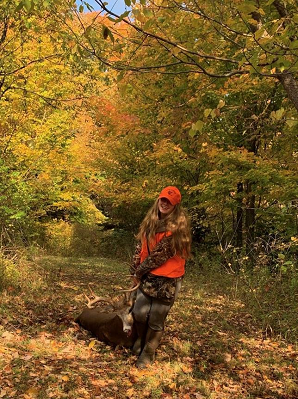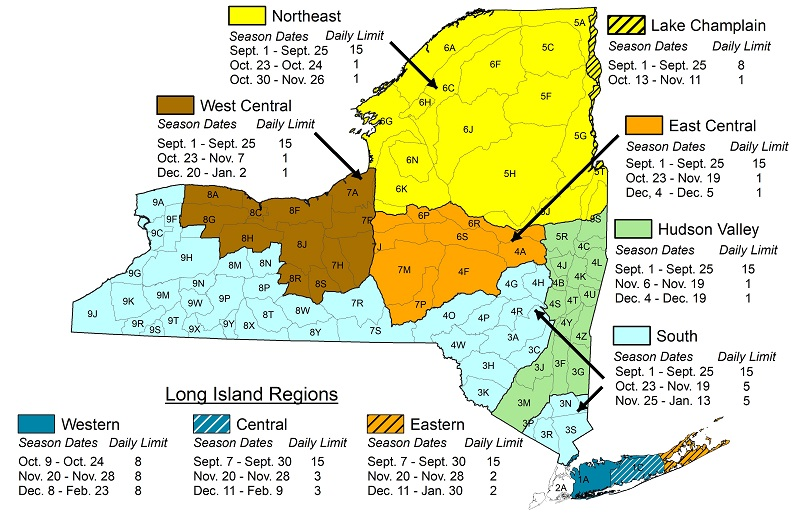Hunting and Trapping Newsletter
The New York State Department of Environmental Conservation sent this bulletin on 05/12/2021 01:08 PM EDT |
| DEC Delivers - Information to keep you connected and informed from the NYS Department of Environmental Conservation |
| Share or view as a web page || Update preferences or unsubscribe |
Hunting and Trapping Newsletter |
Hunters in New York Harvested More than 253,000 Deer in 2020-2021The 2020 estimated deer take included 137,557 antlerless deer and 116,433 antlered bucks. Statewide, this represents a 30-percent increase in antlerless harvest and a three-percent decrease in buck harvest from the last season. Across the board, whether with a bow, muzzleloader, or rifle, hunters targeted antlerless deer more in 2020 than 2019, supporting DEC’s management objectives to maintain stable deer populations in most of the State and to reduce deer abundance in a few areas. Hunters took 33,260 deer in the Northern Zone, a 10-percent increase from 2019, primarily due to increased antlerless harvest. Southern Zone hunters took 220,730 deer, a 14-percent increase from 2019, also because of increased antlerless harvest.
See DEC’s 2020 Deer Harvest Summary (PDF) for a full report with tables, charts, and maps detailing the deer harvest around the state. You can find past harvest summaries on DEC’s website. What to Do When Encountering Young Wildlife - If You Care, Leave Them ThereAs spring moves into full bloom, you may encounter young or newborn wild animals. While a baby animal might appear abandoned, it is much more likely that a parent is in the area or the individual is an independent juvenile. Please do not touch a wild baby animal – call your regional DEC office or a licensed wildlife rehabilitator if you are concerned for its well-being.
If you come across a young, wild animal on its own, the best thing to do is leave it where it is and observe from a distance. The parents may not approach their young if they sense you in the vicinity. For more guidance, you can contact a regional DEC office or a wildlife rehabilitator. You can find a list of licensed wildlife rehabilitators as well as more information on young wildlife on the DEC website. Cottontail photograph taken by Katrina Susman DEC Announces 2021-2022 Waterfowl Hunting Season DatesWaterfowl News:
Other Changes From Last Year Include:
Youth and Military Waterfowl Hunting OpportunitiesDuck hunting seasons begin with designated youth and military waterfowl hunts across the state. The youth hunting days allow young hunters the opportunity to spend time afield with experienced adult hunters and gain necessary knowledge and skills to become safe and responsible members of the hunting community. Junior hunters (12 to 15 years of age) accompanied by a licensed adult hunter with up-to-date Harvest Information Program registration and a duck stamp may participate. During the youth hunt, the adult hunter may not possess a firearm or shoot any birds unless the respective regular season is open. Daily bag limits are the same as those allowed during the regular hunting season for all species (e.g. one per day in the West Central Canada goose zone and five per day in the South). Youth dates:
Military hunting days were added late last year and provide an additional two days for our service members (active duty and veterans) to pursue waterfowl with less competition than there would otherwise be during the regular hunting season. Daily bag limits are the same as those allowed during the regular hunting season for all species (e.g. one per day in the West Central Canada goose zone and five per day in the south). Military dates:
* As a shared zone, Lake Champlain dates in New York are chosen by the Vermont Fish and Wildlife Management board. Vermont does not currently offer military hunting days, thus no dates were selected. 2021-2022 Duck Season DatesStarting with the 2019-2020 duck season, DEC, with the assistance of Cornell University and the Waterfowl Hunter Task Forces, implemented a new process for selecting duck season dates in the four main zones of the state. The process incorporated input from a greater number of duck hunters through a structured survey and utilizes recent duck migration and abundance trends that were specific to each zone to maximize opportunity. With no changes anticipated in the federal frameworks (i.e., season length) for 2021-2022, the duck seasons dates in each zone will be:
For more information on how these dates were determined for each zone, visit DEC's website. DEC intends to reassess hunter values after the 2023-2024 hunting season. At that time, DEC will also update duck migration data to ensure there have been no significant changes to the timing of duck movements through each zone. Canada Goose SeasonsCanada goose hunting regulations can often be confusing because of the number of zones, varied bag limits, and season lengths. Although some of the boundaries and bag limit differences appear to be random, they were designed using scientific data to maximize opportunity for resident Canada geese, but also to protect migratory populations that are much more sensitive to hunter harvest. Season lengths and bag limits are, again, developed in collaboration between the US Fish and Wildlife Service and the Atlantic Flyway Council. After the season frameworks are established (e.g., season length, bag limits, outside allowable dates), DEC gathers input from waterfowl hunters and the waterfowl hunter task forces to select dates that maximize opportunity for hunters in each zone.
Bag Limits for All Other SpeciesThere are no changes to season dates or bag limits for any of the other webless migratory game birds (rails, gallinules, snipe, and American woodcock). For more information and season dates for these species, please visit DEC's website. |

 Increased antlerless harvests may have been due, at least in part, to additional hunters and renewed motivation to harvest venison during the ongoing COVID-19 pandemic. Overall, the number of licensed big game hunters increased to just over 588,000, approximately seven percent more than 2019. The number of bowhunters increased 10 percent, reaching a new high of more than 251,000, and the number of muzzleloader hunters increased six percent to more than 253,600. And after several years of declining participation, the number of youth deer hunters ages 14 to 15 increased by 23 percent. With these additional hunters, DEC issued approximately six percent more Deer Management Permits (antlerless tags) than in 2019, and hunters were more successful filling DMPs at a greater rate than prior years, resulting in a 34-percent increase in DMP harvest.
Increased antlerless harvests may have been due, at least in part, to additional hunters and renewed motivation to harvest venison during the ongoing COVID-19 pandemic. Overall, the number of licensed big game hunters increased to just over 588,000, approximately seven percent more than 2019. The number of bowhunters increased 10 percent, reaching a new high of more than 251,000, and the number of muzzleloader hunters increased six percent to more than 253,600. And after several years of declining participation, the number of youth deer hunters ages 14 to 15 increased by 23 percent. With these additional hunters, DEC issued approximately six percent more Deer Management Permits (antlerless tags) than in 2019, and hunters were more successful filling DMPs at a greater rate than prior years, resulting in a 34-percent increase in DMP harvest. Many wildlife parents leave their young in a safe place, where they instinctively remain quiet and still to avoid detection by predators. The parents return periodically (sometimes only a few times within 24 hours) to feed the young. Fawns, cottontail rabbits, fledgling birds are the most common species that are mistakenly “rescued” by people thinking that the animals have been abandoned. Unfortunately this leads to the death of many young animals, as wildlife is difficult to raise in captivity. It is also illegal to rehabilitate or keep wildlife in captivity without a license.
Many wildlife parents leave their young in a safe place, where they instinctively remain quiet and still to avoid detection by predators. The parents return periodically (sometimes only a few times within 24 hours) to feed the young. Fawns, cottontail rabbits, fledgling birds are the most common species that are mistakenly “rescued” by people thinking that the animals have been abandoned. Unfortunately this leads to the death of many young animals, as wildlife is difficult to raise in captivity. It is also illegal to rehabilitate or keep wildlife in captivity without a license.